|
 Secure Site
Secure Site
|
 |
Archive for the 'mindfulness practice' Category
 Dream, Pablo Picasso Birds do it. Cats do it. And Spaniards most especially do it—every day, in broad daylight.
They nap. Proudly, without a hint of embarrassment. Grown adults—executives, teachers, civil servants—wink off in the middle of the workday like kindergartners at mat time. From 1 or 2 o’clock to 4:30 or so every afternoon, Spain stops the world for a stroll home, a leisurely meal, a few z’s. Common Market technocrats have informed the Spanish that this is not the way things will get done in the oft-threatened unified Europe. The Spanish reply with a flourish of rioja and snooze alarms. ¡Viva siesta!
At a time when productivity is the world’s largest religion, the siesta tradition lives on. In Spain, work operates under the command of life, instead of the other way around. No task is so critical that it can’t wait a couple of hours while you attend to more important matters like eating, relaxing, or catching up on sleep from a night on the town. When the midday break hits, offices empty and streets clear as if by the hand of Rod Serling. Befuddled foreigners left behind quickly learn that they have entered a new circadian order.
Taking a long break in the middle of the day is not only healthier than the conventional lunch; it’s apparently more natural. Sleep researchers have found that the Spanish biorhythm may be tuned more closely to our biological clocks. Studies suggest that humans are “biphasic” creatures, requiring days broken up by two periods of sleep instead of one up-till-you-drop “monophasic” shift. The drowsiness you feel after lunch comes not from the food but from the time of day. “All animals, including humans, have a biological rhythm,” explains Claudio Stampi, director of the Chrono Biology Research Institute in Newton, Massachusetts. “One is a 24-hour rhythm—we get tired by the end of the day and go to sleep—and there is a secondary peak of sleepiness and a decrease in alertness in the early afternoon. Some people have difficulty remaining awake, doing any sort of task between one and four in the afternoon. For others it’s less difficult, but it’s there. So there is a biological reason for siestas.”
 Digital Zen Alarm Clocks, available in maple, walnut, bamboo, and black lacquer Unlike the average lunch break, the siesta is a true break in the action because there is no choice but to come to a full and complete stop. You can’t do errands; the shops are closed. You can’t make business calls; nobody’s at the office. Most people go home for lunch, or get together with family or friends for a glass of vino, and nod out afterwards.
Like a lot of us in the land of time scarcity, I find it harder and harder to shut it off, to switch off work mode and be social—that is, be unproductive, and just be. The divide is blurred by a volatile economy of all-consuming competition that has turned off-hours into off-site catch-up. Blink and it’s Monday again. The culprit, says David Scott, an associate professor of recreation, park, and tourism sciences at Texas A&M, is the accelerating cult of efficiency.
“We are an efficiency-oriented society,” he says. “It is perhaps the dominant value in this culture. The faster things get done, the better off we’re going to be. The idea of efficiency at all costs seems to be all-pervasive. It tends to invade our leisure. Unfortunately, socializing doesn’t have a ‘yield.’ It’s hard to develop relationships; those things take time.”
The siesta lifestyle is rooted in a culture with values that are anathema to the ascendant economic order, so don’t expect the rest of Europe to adopt Spanish hours. A few Spanish firms have begun shortening their siesta time as the eurodollar era approaches. But maybe, being the great taskmasters we are, we could find a way to put one quality-of-life item on the agenda each day. We could even give it a productive rationale: Life expectancy in Spain is two years longer than in the United States. Think of all that extra output.
Our Digital Zen Clock’s long-resonating Tibetan bell-like chime makes waking up a beautiful experience – its progressive chimes begin your day with grace. When the clock’s alarm is triggered, the acoustic chime bar is struck just once … 3-1/2 minutes later it strikes again … chime strikes become more frequent over 10 minutes … eventually striking every 5 seconds until shut off. As they become more frequent, the gentle chimes will always wake you up – your body really doesn’t need to be awakened harshly, with a Zen Clock you’re awakened more gradually and thus more naturally.
What makes this gentle awakening experience so exquisite is the sound of the natural acoustic chime, which has been tuned to produce the same tones as the tuning forks used by musical therapists. According to the product’s inventor, Steve McIntosh, “once you experience this way of being gradually awakened with beautiful acoustic tones, no other alarm clock will ever do.”
adapted from Escape Mazaine, July 1998
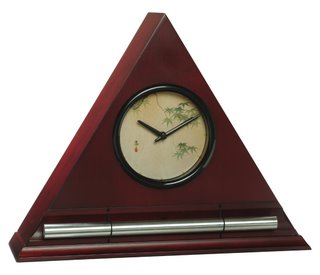 Japanese Leaves Dial Face in Burgundy Finish by Now & Zen Now & Zen – The Peaceful Chime Alarm Clock Store
1638 Pearl Street
Boulder, CO 80302
(800) 779-6383
Posted in Chime Alarm Clocks, Japanese Inspired Zen Clocks, mindfulness practice, Natural Awakening, Now & Zen Alarm Clocks, Progressive Awakening, Sleep Habits, Well-being
 Toyohara, Kunichika, 1835-1900 Saruwaka-cho Kogiku Too frazzled to focus at work? Meditation may help hone your attention — even if you’re new to the practice. In a University of Pennsylvania study, a group of 17 beginners showed great improvements in focus after meditating for a half-hour, five times a week for eight weeks. Regular meditation also enhanced their ability to manage tasks and stay alert while working.
To ease into a practice, find a quiet place every day, set your Zen Meditation Timer and simply focus on following your breath. “Even if you’re doing five minutes, three times a day, it can help a lot in getting your body accustomed to slowing down,” says Vandita Kate Marchesiello, director of the Kripalu Yoga Teachers Association. For more guidance, she recommends picking up a meditation book, CD, or DVD, or attending a local class.
Our Mindfulness Clock & Timer, called The Zen Clock serves as a countdown and interval timer for yoga, meditation, bodywork, etc.; and it can also be set to chime on the hour as a tool for “mindfulness.”
adapted from Body + Soul, October 2007
 Black Lacquer Zen Alarm Clock and Meditation Timer
Now & Zen’s Mindfulness Clocks and Timer Store
1638 Pearl Street
Boulder, CO 80302
(800) 779-6383
Posted in Bamboo Chime Clocks, Chime Alarm Clocks, intention, Meditation Timers, Meditation Tools, mindfulness practice, Now & Zen Alarm Clocks, Ukiyo-e, Well-being
 Utamaro Kitagawa, Bijin Combing Her Hair, 1750-1806 The key to create a wind-down period before bedtime is to create some space between your busy day and sleep time. “You can’t just work until 9 at night, and then stick your head on the pillow and fall asleep,” Khalsa says. So turn off the television, computer, and radio. Cut down on or eliminate evening classes and exercise that leaves you feeling amped up.
When you come home, honor this transition by playing relaxing music, lighting candles, or putting on your favorite pajamas and set your Zen Alarm Clock. Think of the yoga precept of pratyahara: Withdraw your senses in order to turn inward.
Our unique “Zen Clock” features a long-resonating acoustic chime that brings the meditation session to a gradual close, preserving the environment of stillness while also acting as an effective time signal.
adapted from yogajournal.com ‘Sweet Slumber’ by Nora Isaacs
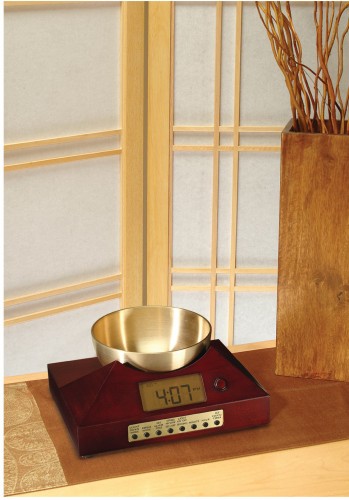 Zen Alarm Clock for a Gentle Awakening with a Bowl Gong
Now & Zen’s Chime Timer
1638 Pearl Street
Boulder, CO 80302
Posted in Bamboo Chime Clocks, Japanese Inspired Zen Clocks, Meditation Timers, Meditation Tools, mindfulness practice, Natural Awakening, Now & Zen Alarm Clocks, Progressive Awakening, Sleep Habits, Ukiyo-e, Well-being, Zen Timepiece by Now & Zen, Zen Timers
 yoga downward dog pose This multipurpose pose stretches and releases tension in key parts of your body (shoulders, legs) while at the same time strengthening and toning them. Make it part of your regular practice and feel your energy soar.
Here’s How To Do It
Start on all fours on a yoga mat, with your hands aligned with your shoulders and your knees directly under your hips. The tops of your feet should be on the mat.
Inhale, curl your toes under, and spread your fingers. Exhale, raise your tailbone, and push into the mat with your hands. Elongate your spine, and straighten your legs. Keeping your head neutral and your back flat, activate the muscles in your arms and legs. Push your heels down toward the floor. Hold for four to five breaths. Bend your knees and relax. Set your Zen Yoga Timer to 30 seconds.
Refine Your Technique
As you incorporate the pose into your practice, use the following strategies.
1. Spread your fingers as wide as possible, pressing the base of your index fingers into the floor.
2. Keep your head between your arms or let it hang, whatever feels more comfortable.
3. Lengthen your spine, lifting your sitting bones up; imagine someone pulling your hips and back.
4. Keep your knees straight, but not locked. Hold the outer thigh muscles firm, and roll the upper thighs slightly inward.
5. Your heels may or may not reach the floor; keep stretching them, but don’t strain.
6. Hold your shoulder blades firm, drawing them in and down, toward your tailbone.
adapted from Body + Soul Magazine, November 2009 by Tania Hannan
Use our unique “Zen Clock” which functions as a Yoga Timer. It features a long-resonating acoustic chime that brings your meditation or yoga session to a gradual close, preserving the environment of stillness while also acting as an effective time signal. Our Yoga Timer & Clock can be programmed to chime at the end of the meditation or yoga session or periodically throughout the session as a kind of sonic yantra. The beauty and functionality of the Zen Clock/Timer makes it a meditation tool that can actually help you “make time” for meditation in your life. Bring yourself back to balance.
 Digital Zen Alarm Clocks, yoga timers with a chime
Now & Zen – The Yoga Chime Timer Store
1638 Pearl Street
Boulder, CO 80302
(800) 779-6383
Posted in Bamboo Chime Clocks, Chime Alarm Clocks, Meditation Timers, Meditation Tools, mindfulness practice, Now & Zen Alarm Clocks, Well-being, Yoga Timer, Yoga Timers by Now & Zen
Just Breathe
 meditation, just breathe Find a comfortable seated position and begin by observing your natural breath. Notice the texture, length, and rhythm as the breath flows in and out of your body. Feel the temperature of the air as it touches your nostrils. Take note, too, of pauses between breaths.
As thoughts arise, note them, but then allow them to float by like clouds, gently bringing your attention back to the breath. If you find it difficult to concentrate, try silently counting. For example, inhale 1, exhale 1, inhale 2, exhale 2, up to 10, and then repeat the cycle. After a while, you can stop counting and just focus on your natural breath.
Although meditation can be done in almost any context, practitioners usually employ a quiet, tranquil space, a meditation cushion or bench, and some kind of timing device to time the meditation session. Ideally, the more these accoutrements can be integrated the better. Thus, it is conducive to a satisfying meditation practice to have a timer or clock that is tranquil and beautiful. Using a kitchen timer or beeper watch is less than ideal. And it was with these considerations in mind that we designed our digital Zen Alarm Clock and practice timer. This unique “Zen Clock” features a long-resonating acoustic chime that brings the meditation session to a gradual close, preserving the environment of stillness while also acting as an effective time signal. The Digital Zen Clock can be programmed to chime at the end of the meditation session or periodically throughout the session as a kind of sonic yantra. The beauty and functionality of the Zen Clock/Timer makes it a meditation tool that can actually help you “make time” for meditation in your life.
adapted from Yoga Journal, ‘Presence of Mind’ by Janice Gates
 Zen Alarm Clock with Progressive Chime Now & Zen’s Mindfulness Timer Store
1638 Pearl Street
Boulder, CO 80302
Posted in Bamboo Chime Clocks, Chime Alarm Clocks, Japanese Inspired Zen Clocks, Meditation Timers, Meditation Tools, mindfulness practice, Natural Awakening, Now & Zen Alarm Clocks, Progressive Awakening, Yoga Timer, Yoga Timers by Now & Zen, Zen Timepiece by Now & Zen, Zen Timers
 how to get back to sleep One minute, you’re in the deep REM zone. The next, it’s 3 a.m. and you’re wide awake, eyes flung open, heart pounding, mind racing like a runaway train — “Will I meet that deadline?” “Did I turn off the stove?”
You lie there flustered, tossing and turning, until finally you give up — and spend the next few hours zoned out on the couch watching infomercials.
While you can’t ignore late-night anxiety, you can find calm by facing it head on. “Mindfulness makes you aware of the uncomfortable physical sensations that bubble up when your brain refuses to rest,” says stress and relaxation expert KRS Edstrom, creator of the Sleep Through Insomnia meditation CD. “It helps break up those I-can’t-fall-back-to-sleep thoughts, and lets your mind know it doesn’t have to panic anymore.”
When insomnia strikes, she suggests briefly getting out of bed (get a drink of water, gently stretch) to break the initial agitation. Then lie back down and, using the following visualization technique, focus your attention on how you feel. By observing the tension in your body, you’ll be better able to let it go and catch those precious remaining hours of rest.
Meditation How-To
1. Lie on your back, close your eyes, and take three deep, slow breaths through your nose.
2. Turn your attention to where the panic or tension resides in your body. Is it your head? Throat and neck? The pit of your stomach?
3. Observe the sensation. Does it feel dull, sharp, prickly, hot? Describe it to yourself objectively, without trying to make it stop or go away.
4. Now imagine drawing a circle around that spot with a marker.
5. Breathe deeply in and out for a few moments, watching the circle expand and shrink. Notice whether the intensity swells, plummets, or changes shape over time. As you relax, begin to envision the circle slowly melting away.
6. As the circle dissolves, let your body grow heavy; imagine that your bones are made of lead, sinking deeper and deeper into the bed. Feel a wave of relaxation flow over you, washing away your remaining anxiety, like sand being drawn out to sea.
7. Drift blissfully to sleep.
The Digital Zen Clock and Meditation Timer serves as a countdown and interval timer for yoga, meditation, bodywork, etc.; and it can also be set to chime on the hour as a tool for “mindfulness.”
adapted from Body + Soul Magazine, September 2008
 Natural Sounding Alarm Clocks, The Digital Zen Alarm Clock in Solid Walnut Now & Zen’s Meditation Timer Shop
1638 Pearl Street
Boulder, CO 80302
(800) 779-6383
Posted in intention, Meditation Timers, mindfulness practice, sleep, Sleep Habits, Well-being
 Soothe your little sweetie with a gentle massage Empirical research suggests our appreciation of massage starts early—as tastes go, it’s one that needs little acquiring. That’s certainly the message behind the growing trend of infant massage, where mothers and fathers (and sometimes caretakers) bond with their wee ones through loving touch and improve their overall health. Parents, nurses, and doctors say that massage helps babies grow better, improves digestion, and eases colic. Studies conducted at the Touch Research Institutes at the University of Miami School of Medicine show that infant massage facilitates weight gain in preterm infants, decreases babies’ level of stress hormones, and balances out their sleep/wake cycle. “Nurturing touch is important for children’s physical, social, behavioral, mental, and cognitive development,” says Linda Garofallou, an infant and pediatric massage therapist at Children’s Hospital in Newark, New Jersey. She gives infant massage to patients and also trains others in the technique.
To do an infant massage, choose a time when your baby is well fed and rested. Set your Zen Timer for twenty minutes. Put a towel in a quiet room for the baby to lie on, choose a natural oil such as coconut, almond, or avocado, and play relaxing music. Assess the baby’s receptivity by observing her response to your touch. If she is stiff or tense, then use your intuition: either hold her closely in your arms until she relaxes—or wait for another time. A gazing, quiet, yet alert state means she is ready to begin.
 Mom and baby A common stroke, called Indian Milking, entails holding one foot with your hand and then “milking” the leg from the ankle to thigh. Follow this by holding the thigh with both hands and gently twisting and squeezing your hands as you move from thigh to foot. (For more strokes, see Vimala Schneider’s classic book, Infant Massage: A Handbook for Loving Parents [Bantam, 1989] or visit the International Association of Infant Massage, www.iaim.ws/home.html, to find a certified infant massage instructor near you.)
Babes aren’t the only ones who benefit from infant massage. Experts like Andrea Kelly, ceo of the International Association of Infant Massage in Ventura, California say that giving a massage releases nurturing hormones for both the mother (oxytocin) and the father (prolactin).
In addition to bonding, infant massage helps kids born with addictions or serious health problems, says Joanne Starr, MD, director of pediatric cardiothoracic surgery at Children’s Hospital. She’s seen the positive effects of Garofallou’s infant massage on the tiny heart patients she’s operated on. “I think it’s a very important part of their healing,” says Starr, who adds that many of these infants can’t be held because they are hooked up to ventilators. “It’s such a helpless feeling for the parents, but massage empowers them to do something.”
adapted from Natural Solutions Magazine, October 2007
Although meditation can be done in almost any context, practitioners usually employ a quiet, tranquil space, a meditation cushion or bench, and some kind of timing device to time the meditation session. Ideally, the more these accoutrements can be integrated the better. Thus, it is conducive to a satisfying meditation practice to have a timer or clock that is tranquil and beautiful. Using a kitchen timer or beeper watch is less than ideal.
And it was with these considerations in mind that we designed our digital Zen Alarm Clock and practice timer. This unique “Zen Clock” features a long-resonating acoustic chime that brings the meditation session to a gradual close, preserving the environment of stillness while also acting as an effective time signal.
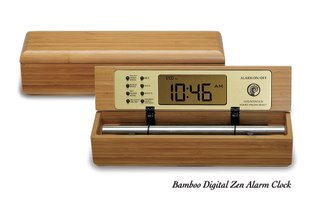 Bamboo Digital Chime Clock, a calming timer and alarm clock made from natural materials like bamboo, walnut, and maple Now & Zen – The Zen Timer Store
1638 Pearl Street
Boulder, CO 80302
(800) 779-6383
Posted in Bamboo Chime Clocks, mindfulness practice, Now & Zen Alarm Clocks, Well-being, Zen Timepiece by Now & Zen, Zen Timers
 can meditation reduce stress? Dhyana heyah tad vrttayah.
Meditation removes disturbances of the mind. (Yoga Sutra II.11)
Research shows that meditation can help people with anxiety disorders. Philippe Goldin, director of the Clinically Applied Affective Neuroscience project in the Department of Psychology at Stanford University, uses mindfulness meditation in his studies. The general practice is to become aware of the present moment—by paying attention to sounds, your breath, sensations in your body, or thoughts or feelings—and to observe without judgment and without trying to change what you notice.
Like most of us, the participants in Goldin’s studies suffer from all sorts of disturbances of the mind—worries, self-doubt, stress, and even panic. But people with anxiety disorders feel unable to escape from such thoughts and emotions, and find their lives overtaken by them. Goldin’s research shows that mindfulness meditation offers freedom for people with anxiety, in part by changing the way the brain responds to negative thoughts.
In his studies, participants take an eight-week mindfulness-based course in stress reduction. They meet once weekly for a class and practice on their own for up to an hour a day. The training includes mindfulness meditation, walking meditation, gentle yoga, and relaxation with body awareness as well as discussions about mindfulness in everyday life.
Before and after the intervention, participants have their brains scanned inside an fMRI (or functional MRI) machine, which looks at brain activity rather than the structure of the brain, while completing what Goldin calls “self-referential processing”—that is, thinking about themselves. An fMRI scanner tracks which brain areas consume more energy during meditation and, therefore, which regions are more active.
Ironically, the brain-scanning sessions could provoke anxiety even in the calmest of people. Participants must lie immobilized on their back with their head held in the brain scanner. They rest their teeth on dental wax to prevent any head movement or talking. They are then asked to reflect on different statements about themselves that appear on a screen in front of their face. Some of the statements are positive, but many of them are not, such as “I’m not OK the way I am,” or “Something’s wrong with me.” These are exactly the kinds of thoughts that plague people with anxiety.
The brain scans in Goldin’s studies show a surprising pattern. After the mindfulness intervention, participants have greater activity in a brain network associated with processing information when they reflect on negative self-statements. In other words, they pay more attention to the negative statements than they did before the intervention. And yet, they also show decreased activation in the amygdala—a region associated with stress and anxiety. Most important, the participants suffered less. “They reported less anxiety and worrying,” Goldin says. “They put themselves down less, and their self-esteem improved.”
Goldin’s interpretation of the findings is that mindfulness meditation teaches people with anxiety how to handle distressing thoughts and emotions without being overpowered by them. Most people either push away unpleasant thoughts or obsess over them—both of which give anxiety more power. “The goal of meditation is not to get rid of thoughts or emotions. The goal is to become more aware of your thoughts and emotions and learn how to move through them without getting stuck.” The brain scans suggest that the anxiety sufferers were learning to witness negative thoughts without going into a full-blown anxiety response. Research from other laboratories is confirming that mindfulness meditation can lead to lasting positive changes in the brain. For example, a recent study by Massachusetts General -Hospital and Harvard University put 26 highly stressed adults through an eight-week mindfulness-based course in stress reduction that followed the same basic format as Goldin’s study. Brain scans were taken before and after the intervention, along with participants’ own reports of stress. The participants who reported decreased stress also showed decreases in gray -matter density in the amygdala. Previous research had revealed that trauma and chronic stress can enlarge the amygdala and make it more reactive and more connected to other areas of the brain, leading to greater stress and anxiety. This study is one of the first documented cases showing change ocurring in the opposite direction—with the brain instead becoming less reactive and more resilient.
Together, these studies provide exciting evidence that small doses of mental training, such as an eight-week mindfulness course, can create important changes in one’s mental well-being.
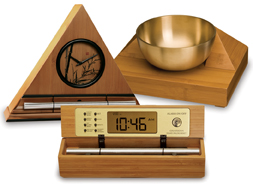 Zen Meditation Timers and Clocks - Boulder, CO Our Zen Meditation Timer’s acoustic 6-inch brass bowl-gong clock is the world’s ultimate alarm clock, practice timer, and “mindfulness bell.”
It fills your environment with beautifully complex tones whenever it strikes. In the morning, its exquisite sounds summon your consciousness into awakening with a series of subtle gongs that provide an elegant beginning to your day. It also serves as the perfect meditation timer.
adapted from Yoga Journal, by Kelly McGonigal
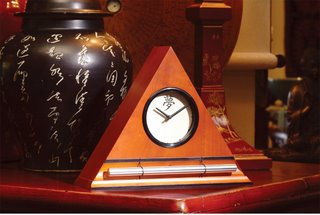 meditation tools and gentle alarm clocks Now & Zen’s Meditation Timer & Alarm Clock Shop
1638 Pearl Street
Boulder, CO 80302
(800) 779-6383
Posted in Chime Alarm Clocks, intention, Meditation Timers, Meditation Tools, mindfulness practice, Well-being, Zen Alarm Clock, Zen Timers
 meditation Put it into practice.
Sit comfortably in a place where you won’t be disturbed. Take three to five quiet breaths. Gently close your eyes.
Imagine the horizon spanning through your chest with a radiant sun rising in your innermost center—your heart. As though being melted by the solar warmth, release tension in your shoulders and across your throat. Soften your forehead and rest your attention inward on the light deep within. Take
7 to 10 smooth, even breaths. Set your Zen Meditation Timer to repeat and chime every 10 seconds to help you time your breathing.
As you inhale, invite the glow from your heart to expand toward the inner surface of the body. With each exhale, let the light recede. Take another 7 to 10 peaceful breaths. Inhaling, invite the light to touch the parts of you that interact with the world—your eyes and ears, the voice center in your throat, the palms
of your hands, the soles of your feet. Exhaling, feel your light shine more clearly. As you continue to inhale and exhale, silently say: “I radiate friendliness for those who are happy, com-passion for those who are unhappy, equanimity toward all.” Continue until your attention wavers. Then, sit quietly for several minutes.
When you feel complete, place your palms together in front of your heart and bow your head. Release the backs of your hands to your thighs and lift your head. Gently open your eyes to return to the horizon of the world.
adapted from Yoga Journal by Kate Vogt
 Zen timers for meditation and yoga Now & Zen – The Zen Meditation Timer Shop
1638 Pearl Street
Boulder, CO 80302
(800) 779-6383
Posted in intention, Meditation Timers, Meditation Tools, mindfulness practice, Well-being, zen, Zen Timepiece by Now & Zen, Zen Timers
 mediation As the evidence for the benefits of meditation grows, one of the most important outstanding questions is, How much is enough? Or, from the perspective of most beginning meditators, How little is enough to see positive change?
Researchers agree that many of the benefits happen early on. “Changes in the brain take place at the very beginning of learning,” Luders says. And many studies show change in a matter of weeks, or even minutes, among inexperienced meditators. But other studies suggest that experience matters. More practice leads to greater changes, both in the brain and in a meditator’s mental states. So while a minimal investment in meditation can pay off for your well-being and mental clarity, committing to the practice is the best way to experience the full benefits.
Luders, who was a lapsed meditator when she started her research, had such a positive experience being around seasoned meditators that she was motivated to come back to the practice. “It’s never too late,” Luders says. She suggests starting small and making meditation a regular habit. “The norm in our study was daily sessions, 10 to 90 minutes. Start with 10.”
If you do, you may discover that meditation has benefits beyond what science has revealed. Indeed, it will take time for science to catch up to the wisdom of the great meditation teachers. And even with the advances in brain technology, there are changes both subtle and profound transmitted only through direct experience. Fortunately, all you need to get started is the willingness to sit and be with your own body, breath, and mind.
adapted from Yoga Journal, by Kelly McGonigal
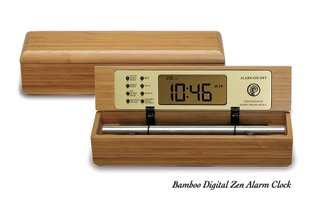 Bamboo Meditation Timer & Gentle Alarm Clock - Boulder, CO The Bamboo Digital Zen Clock’s long-resonating Tibetan bell-like chime makes waking up a beautiful experience – its progressive chimes begin your day with grace. When the clock’s alarm is triggered, the acoustic chime bar is struck just once … 3-1/2 minutes later it strikes again … chime strikes become more frequent over 10 minutes … eventually striking every 5 seconds until shut off. As they become more frequent, the gentle chimes will always wake you up – your body really doesn’t need to be awakened harshly, with a Zen Clock you’re awakened more gradually and thus more naturally. Unlike artificial recorded sounds coming out of a tiny speaker in a plastic box, natural acoustic sounds transform your bedroom or office environment.
The Digital Zen Clock also serves as a countdown and interval timer for yoga, meditation, bodywork, etc.; and it can also be set to chime on the hour as a tool for “mindfulness.”
 Meditation Clocks and Timers from Now & Zen Now & Zen’s Meditation Timer & Alarm Clock Shop
1638 Pearl Street
Boulder, CO 80302
(800) 779-6383
Posted in intention, Meditation Timers, Meditation Tools, mindfulness practice, Well-being, zen, Zen Alarm Clock, Zen Timers
« Previous Page — « Previous Entries
Next Entries » — Next Page »
|
|
|
|